MOUNTAIN BIKE TIRES
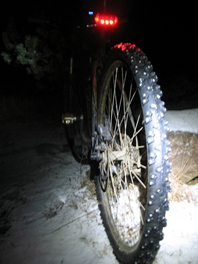
Mountain bike tires can make your ride pleasant or painful.
The tires that go on mountain bikes are different than regular bike tires because they are designed to give the rider more traction and grip when they are on trails or inclines namely hills!
It is this traction and grip that sets them apart from other tires. You'll want to decide the terrain you ride most and get a tire that fits your area. Or if you can afford a couple of pair of tires this will really give you an edge.
Tubeless or Tubes
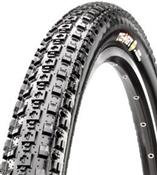
You'll want to check your wheel set before buying mountain bike tires. If you have a tubeless wheel set, I recommend tubeless though you can use a regular tire and tubes.
Tubeless are great and I have rode them for the past 4 years. I will not go back. Many do not like them for adventure racing worrying about flats, but I have never had a flat while racing and only once since I started riding tubeless.
I got the flat because my tire pressure was to low.
For tubeless, you can ride at a lower tire pressure and you do not need tubes. If you get a flat that tears the tire. Do not worry. You can still insert a tube.
I was sponsored by Maxxis for a while and the
tire in the picture
is the tire I really liked. I used it for adventure racing in Michigan and at Montana.
Mountain Bike Tires for the Mud
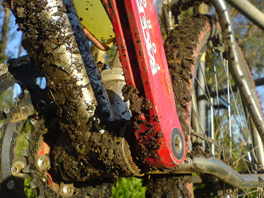
Tires for the mud will have wide channels that allow mud to flow instead of cake.
A tire in the rear with wide horizontal treads in the center and wide knobs on the sides are good for mud.
You definitely want tires designed for the mud as riding with other tires can be quite annoying. The mud will cake, then your wheels won't turn, then you must carry your bike or scrape the mud...only to be repeated when you get back on.
 I know this because we did this at Primal Quest. Obviously we do not ride tires designed for mud as our terrain is so diverse. The tires we had did horrible in the mud.
I know this because we did this at Primal Quest. Obviously we do not ride tires designed for mud as our terrain is so diverse. The tires we had did horrible in the mud.
The
tires pictured above
shed mud well.
Mountain Bike Tires for Hard Pack

Dry hard pack conditions call for a tire with treads closer together and deeper for traction on lose terrain.
For gripping in tight corners you can get super-tacky tires which have a softer rubber compound. These do wear out more quickly however.
Semi-Slick Mountain Bike Tires

Semi-slick tires have no tread in the middle but knobs on the outside. These are for those of you who spend some time on jeep roads or paved roads as well as the trail.
They do not handle as well on rough terrain and you'll get a lot of slippage. You'll get traction while cornering however.
What mountain bike tires are best?
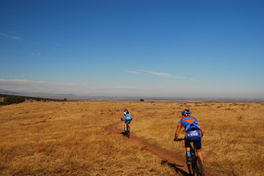
There are some good grands to consider. These are the brands I like and my team and I have raced on.
Hutchinson, Maxxis and Specialized.
Panaracer is a good entry level tire and will hold up well. The best place we have found for tires with great prices and good customer service is
Jenson USA.
I discovered them not to long ago and I like them much better than the other on-line dealers I was using.
What tire pressure should I use in my mountain bike tires?
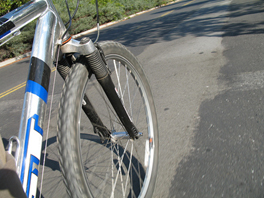
Tire pressure is important but it is also individual. I ride at a very high psi.
It really depends on the rider and the way the mountain bike feels for them. Ideally however, the mountain bike should have tire pressure that allows the rider to make inclines with some ease.
If the tire pressure is too low it will make it difficult to ride and the rider could feel as though the tires on the mountain bike are actually flat. This causes the rider to put even more effort into riding than they really need to if the tire pressure had a bit more air in them. The main problem is you can get pinch flats if the tire pressure is too low.
In addition tires that have too much air pressure can make the rider feel as if the bike is not really getting contact with the ground and this makes for less traction and control of the mountain bike overall. I had too much on a rocky, wet trail. I thought I had lost all my skills. I then let a little air out and boy did my seat and skills appreciate it!
The key to the best possible tire pressure is to determine what actually works for you. For example, put the air pressure in the mountain bike tire and if it doesn’t feel right, simply let some of the air out until it is at a pressure you find is comfortable. Keep in mind that low air could cause pinch flats too.
You can start with a tire pressure of 40-50 psi for 2.2-2.3 inch tires.
If your running tubeless start lower 30 to 40 psi.If you are heavy or have smaller tires go with a higher pressure.
See how this pressure feels cornering and handling rough terrain. Now drop your tire pressure by 5 psi. See the difference in the handling. The bike should hug the ground now and eat up hills faster.
Continue until you find the lowest tire pressure you can ride with and not get pinch flats.
Pinch flats are when the tire and tube get pinched between the object and the rim of the wheel.
With a lower tire pressure you do create some rolling resistance. Adventure racers may ride with a higher tire pressure to eliminate this, but they will lose some control. I for one run a higher tire pressure.
What size mountain bike tire should I use?
The bigger tire offers you more comfort and control. But bigger tires are heaver. It can make the bike feel heavy.
Smaller tires offer you lightweight tires with agility and better pedaling efficiency.
If you ride smooth trail's you can use a smaller tire..1.9" to 2.1" range.
If your ride rough stuff with loose rocky stuff you should go with the 2.25" to 2.35" range. If you ride FreeRide or downhill go even bigger.
I actually went to a very small tire for an adventure racer. It was hard at first, but now that I use it I will not go back. It feels light and free.
For more information about tires and how to buy the right bike for go to
How To Buy a Mountain Bike.
Return Mountain Biking Riding from Mountain Bike Tires
Home










